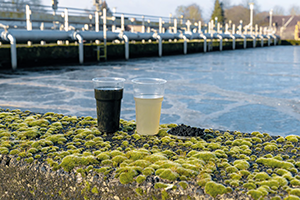

Almost 2 million tonnes of sewage sludge annually are produced in around 10 000 sewage treatment plants in Germany. While previously most sludge has been used as fertiliser in agriculture, more and more is now being recycled thermally for environmental reasons.
However, before the sludge can be used as fuel, its solid material must be separated from the high water content. This is where the company ISV-Umwelt from Langelsheim in Lower Saxony comes into play. Founder and managing director, Sven Penkwitt, explains: “We build mobile biomass dewatering plants and rent them to our customers on a temporary or permanent basis. One of these customers is the municipal sewage treatment plant in Diepholz, where ISV-Umwelt sets up one of its plants for a one week period about four times a year.”
Separation with centrifuge
The separation plant is a self-sufficient system, housed in a 12-metre-long mobile container. The centrepiece is a decanter centrifuge. Its drum rotates at 3200 rpm, generating centrifugal forces equivalent to 3000 times gravitational acceleration. When the sewage is fed from the collection basins, the heavy solids are pressed outwards. From there, they are led to the outside by means of screw conveyors, while the lighter water remains in the centre of the drum and flows off. A conveyor belt then takes the solids to a collection container for transport to the CHP plant. Flocculants are used to optimise the separation process with dosage adjusted according to the composition of the sludge.
Monitoring the centrifuge
The two main bearings of the centrifuge are subject to extreme forces when the heavy drum spins the inhomogeneous sludge at enormous speed. Therefore two VVB vibration sensors from ifm electronic have been screwed into each bearing. They permanently monitor the vibration behaviour.
A vibration pattern that deviates from normal allows quick detection of whether the mass can be processed or not. Then the service staff can intervene and for example, reduce the speed of the centrifuge to prevent damage.
Wear on the drum bearings is also detected at an early stage via increasing vibration amplitude and reported as a maintenance signal. What is more, the vibration sensor has an integrated temperature sensor. Increasing temperature values indicate increased friction due to wear.
Hydraulic unit
An hydraulically-driven screw conveyor located in the centre axis of the centrifuge discharges the solids after compacting them. The pressure is generated by an electrically-driven hydraulic unit. A PV8 pressure switch with a measuring range of 0 to 250 bar measures the hydraulic pressure to control the electric pump motor via a frequency converter. The pressure is therefore used to control the screw drive and ultimately the solids discharge of the plant.
There is also an LI5 series level sensor to detect the oil level and temperature. It gives a warning when permissible values are exceeded.
Feed flow monitoring
Precisely metered inflow of sewage sludge into the centrifuge is crucial for an efficient separation process. For this purpose, a magnetic flow sensor is installed in the inflow. This sensor reliably detects the flow of a wide variety of liquid and viscous media, in this case the amount of sludge that is added, at a rate from 15-56 cubic metres per hour. The measured value is combined with both the feed pump and the centrifuge control in the plant controller. The magnetic-inductive measuring principle offers the following advantage: the measuring section is free of any measuring element that solid components of the sludge could adhere to, thus blocking the pipe.
In addition, the sensor also measures the temperature of the conveyed sludge. The viscosity of this sludge is higher in the cold seasons – a decisive factor that must be taken into account when feeding the centrifuge.
Simple and easy with IO-Link
All sensors in this plant use the IO-Link communication protocol. Penkwitt explains the advantages for his company: “IO-Link reduces the wiring effort and allows a much leaner commissioning. Structured wiring essentially consists of screwing connectors to sensors and modules. Sources of error, such as incorrectly connected cables, are eliminated. Our first plants were wired conventionally and we needed about three days for this. Today, with IO-Link, it’s done in three hours.”
While conventional sensors have only switching or analog outputs, IO-Link sensors offer communication right into the sensor. For example, complete parameterisation can be carried out remotely. This makes it easy to optimise the process remotely, right down to the sensor level.
Conclusion
Sensor technology from ifm plus the advantages of IO-Link allow complex plants to be completely automated. However, it is not only the hardware that makes a difference, service counts as well. Penkwitt concludes: “The people at ifm understand what is at stake. They understand and support you both by phone and on site. Parts availability is also excellent: I call by 3 pm and have my sensor the next day. This is of major importance for us because ultimately I am responsible to my customers. That is why we rely on ifm. We get everything we need – competence, reliability and fast turnaround.”

© Technews Publishing (Pty) Ltd | All Rights Reserved